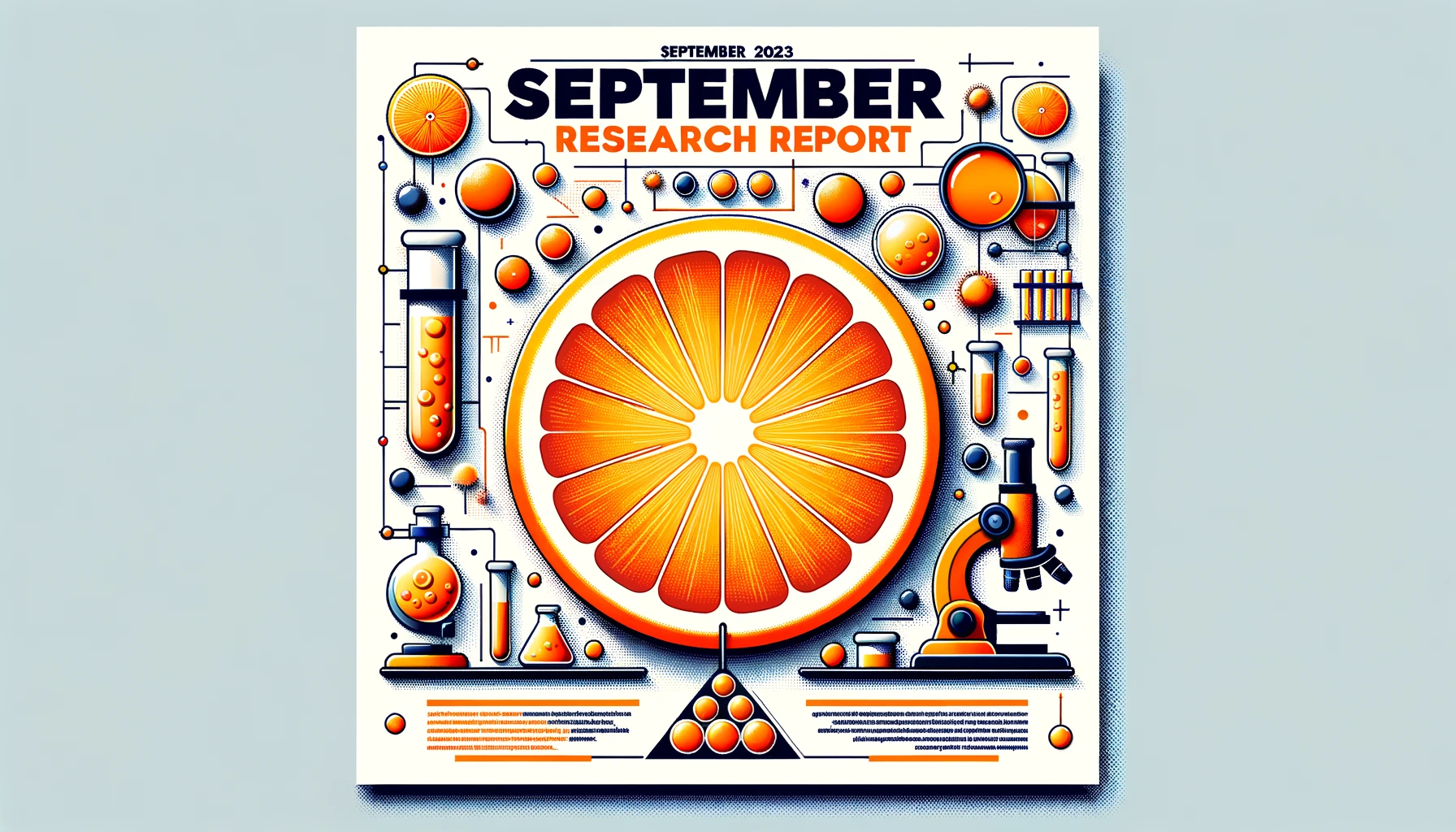Vitamin C Research: Top 5 Discoveries in September 2023

This blog explores new research into the potential benefits and uses of Vitamin C. Using evidence-based research published by expert researchers, the following five topics cover different findings on the potential of Vitamin C.
1. Nutritional Content in School Meals
Nutrition plays a role in children's mental and physical health and academic performance. These studies examine the influence of school meals on children's nutrient intake, considering the contribution of Vitamin C in the meals.
School Meals Can Fulfill Most Nutrient Recommendations, but Vitamin C Falters [1]
A recent study delved into the nutritional value of meals offered through Nigeria's National Homegrown School Feeding Program (NHSFP), specifically focusing on their contribution to student's Recommended Nutrient Intake (RNI). The study meticulously analyzed portion sizes and the content of meals, including critical nutrients such as vitamin C. Interestingly, while the meals contributed significantly to the daily intake of many nutrients such as protein, iron and zinc (up to almost double the recommended level in some cases), they struggled to meet the target for certain key nutrients.
Revealingly, the meals only catered for 3 to 6% of the vitamin C RNI, a finding that points to a pressing need for more vitamin-C rich food items in the school meal programs. Besides, there was also insufficient contribution towards the carbohydrate, fiber, and potassium RNI. To optimize the nutrient content and diversity of school meals, the study recommends increasing portion sizes and variety of meals served, particularly focusing on foods rich in the under-represented nutrients.
Summer Meals Contribute Significantly to Nutrient Goals, but Differ in Vitamin C Content [2]
In a parallel research conducted in the United States, the nutrient value of summer meals for children provided by the U.S. Department of Agriculture was evaluated. Researchers analyzed weekly lunch menus from a host of summer meal sites to deduce their contribution to daily nutrient and energy goals for children aged 9 to 13. Their findings show that these summer lunches did contribute substantially to the daily goals for nutrients and energy.
In contrasting comparisons, the Seamless Summer Option (SSO) programs were seen to provide more vegetables, and therefore higher amounts of vitamins A and C, as well as iron, compared to lunches served by Summer Food Service Program (SFSP) programs. Their sodium content remained below the prescribed daily limit. Nevertheless, despite these disparities, the study concluded that both SSO and SFSP lunches made a meaningful contribution towards nutrient goals for children during the summer. Although not explicitly mentioned, the abstract seems to imply that vitamin C content in these meals could be improved, especially in light of the findings from the parallel study done in Nigeria.
2. Aquatic Organisms Disease Resistance
Vitamin C-loaded nanoparticles are shown to have a positive impact on the disease resistance, immunity and antioxidant activity in shrimps. This suggests a potential role of Vitamin C in protecting aquatic species.
Vitamin C Boosts Disease Resistance and Immunity in Shrimps [3]
One fascinating development is the use of vitamin C-loaded nanoparticles as dietary supplements for aquatic organisms like shrimps. This research focused on the whiteleg shrimp Litopenaeus vannamei, an important representation of aquatic species. The impact of vitamin C, a useful antioxidant, was enhanced by incorporating it into chitosan nanoparticles (CSNPs), which increased its bioavailability. The shrimps were fed these vitamin C-loaded chitosan nanoparticles (VC-CSNPs) and then examined for changes in their antioxidant activity, disease resistance, non-specific immunity, and gene expression. It was discovered that the nanoparticles, categorized as spherical structure and having a positive electrical charge, led to significant improvements in various parameters. The nonchallenged shrimps that were supplemented with the VC-CSNPs showed substantial enhancements in body weight, food efficiency, and survival percentage. Moreover, they showcased improvements in immunological parameters like phenoloxidase, transglutaminase, respiratory burst, total hemocyte counts, and disease resistance. The relative gene expression of lectin, lysozyme, and cMnSOD also notably improved within the VC-CSNPs supplemented groups. All in all, these findings underline the potential utility of VC-CSNPs as dietary enrichment for aquatic species, offering a promising tool in improving disease resistance and overall health.
3. Antibacterial Effectiveness
Research suggests Vitamin C interacts positively with other substances to present antibacterial properties. These findings highlight the possible preventative and treatment roles of Vitamin C regarding bacterial infections.
Vitamin C and Anti-Bacterial Hybrid Nanocomposites Show Promising Results [4]
A comprehensive study investigated the effectiveness of chitosan-cobalt (II) oxide hybrid nanocomposites, a product improved by Vitamin C, against various microorganisms. The researchers utilized a range of analytical techniques to thoroughly analyze the structure of the nanocomposites. The findings confirmed that cobalt oxide molecules interact with the chitosan backbone, a natural compound that enhances its antimicrobial properties. Significant transformations of the chitosan surface were also observed, leading to increased antibacterial functionality against both Gram-positive and Gram-negative bacteria.
But the benefits didn't stop there. They also demonstrated the potential in cancer treatment. The nanoparticle's ability to easily penetrate and destroy cancer cells increased when exposed to UV light. This was linked to an increase in reactive oxygen species (ROS) generation, which aids in impeding cancer cell growth. The nanoparticle's antioxidant capacities were also validated, demonstrating robust antioxidant activities comparable to Vitamin C, further enhancing biological activity. The research concludes that increasing the content of cobalt oxide nanoparticles, further boosts the hybrid nanocomposite's biological activity. This exciting development underscores the multifaceted role Vitamin C plays in our health and wellbeing beyond its traditional understanding as a simple immunity booster.
4. Hydroponics Cultivation
Vitamin C accumulation is more significant in hydroponics cultivation. This research potentially provides benefits for exploring new agricultural practices and improving crop yields and quality.
Hydroponics Enhances Vitamin C Amount in Houttuynia cordata Thunb. [5]
A recent study concentrated on Houttuynia cordata Thunb (HCT), a notable plant famous for its medicinal and food value, particularly in Traditional Chinese Medicine. Researchers were interested in seeing its potential therapeutic value against COVID-19 toxicity. The focus was on examining the plant's growth and the different metabolites under various media - soil, sand, peat, and hydroponics. An interesting discovery was that the hydroponics method produced the highest overall yield of HCT, whereas soil resulted in the highest growth factors like dry rate, chlorophyll content, and vitamin C content. On the other hand, while sand gave a boost to proteins, the peat was more beneficial for total flavonoid accumulation. The significant finding here was that compared to soilless culture, soil produced more harmful derivatives like benzene and carboxylic acids. Scientists conclude that hydroponics, in contrast, minimized the accumulation of these harmful metabolites and increased the accumulation of beneficial medicinal components in HCT. Consequently, HCT demonstrated a strong performance in both medicinal quality and growth when cultivated under hydroponics. This study potentially unlocks new ways in agriculture for better crop yields, quality, and increased vitamin C content.
5. Maternal Diet
Research emphasizes the importance of a maternal diet high in Vitamin C. Deficiencies may result in an increased risk of complications for both mother and baby, pointing to the critical role Vitamin C plays in pregnancy.
Cooking Techniques Preserve Vitamin B [6]
A report reveals the potential impact of various cooking methods on the nutritional value of pork. Out of the four cooking methods evaluated - traditional oven cooking, steaming, vacuum cooking, and sous-vide - no significant differences emerged in terms of fatty acid composition, suggesting that mild temperatures and cooking times conserve these crucial aspects of the meat. Interestingly, the sous-vide and vacuum cooking methods proved superior in maintaining high levels of vitamin B in the cooked meat. However, sous-vide cooking resulted in harder and more chewy meat, attributed to a higher weight loss during the cooking process. The research suggests that the method of cooking can affect not just the taste and texture, but also the nutritional value of food.
Enhanced Technique for Vitamin C Analysis [7]
In a significant breakthrough, a new method was developed for simultaneously measuring the levels of ascorbic acid (AA) and dehydroascorbic acid (DHA) - both forms of vitamin C. This analysis method, which was tested on fruit juice samples, used a simple dilute and shoot method, eliminating the need for time-consuming reduction or derivatization steps. Importantly, the developed method achieved lower limits of quantification for vitamin C forms than previously reported, lending this technique superior precision in determining total vitamin C content. The report suggests that this streamlined analytical method could be widely adopted in quality control labs for the routine analysis of food samples, contributing to more accurate nutritional information for consumers.
Conclusion
In conclusion, Vitamin C is essential for our health, affecting various biological processes and functions. The discussed research highlights Vitamin C's potential in improving nutrition in school meals, defending aquatic organisms against diseases, enhancing antibacterial effectiveness, boosting hydroponics cultivation, and enhancing maternal nutrition during pregnancy. Further research is needed to explore these promising findings and develop practical applications.
References
Zailani, H., Owolabi, O. A., & Sallau, A. B. (2023). Contribution of school meals to the recommended nutrient and energy intake of children enrolled in the National Homegrown School Feeding Program in Zaria, Nigeria. Archives de Pédiatrie, 30(7), 471–476. https://doi.org/https://doi.org/10.1016/j.arcped.2023.07.004
Zimmerman, T., Rothstein, M., Dixit-Joshi, S., Vericker, T., Gola, A. A. H., & Lovellette, G. (2023). USDA Summer Meals Programs: Meeting the Nutritional Needs of Children. Journal of the Academy of Nutrition and Dietetics. https://doi.org/https://doi.org/10.1016/j.jand.2023.09.010
Asaikkutti, A., Vimala, K., Jha, N., Bhavan, P. S., & Arul, V. (2023). Effect of dietary supplementation of vitamin C-loaded chitosan nanoparticles on growth, immune-physiological parameters, and resistance of white shrimp Litopenaeus vannamei to Vibrio harveyi challenge. Animal Feed Science and Technology, 305, 115764. https://doi.org/https://doi.org/10.1016/j.anifeedsci.2023.115764
Bashal, A. H., Khalil, K. D., Abu-Dief, A. M., & El-Atawy, M. A. (2023). Cobalt oxide-chitosan based nanocomposites: Synthesis, characterization and their potential pharmaceutical applications. International Journal of Biological Macromolecules, 253, 126856. https://doi.org/https://doi.org/10.1016/j.ijbiomac.2023.126856
Qi, S., Zha, L., Huang, D., Peng, Y., Li, G., & Yin, D. (2024). Metabolomics and network pharmacology profiling revealed soilless cultivation reduces the accumulation of harmful compounds in Houttuynia cordata. Scientia Horticulturae, 323, 112438. https://doi.org/https://doi.org/10.1016/j.scienta.2023.112438
Sut, S., Lacey, K., Dhenge, R., Ferrarese, I., Santi, S., Cacchioli, A., Gazza, F., Dall’Acqua, S., & Rinaldi, M. (2023). Effect of different atmospheric and subatmospheric cooking techniques on physical and chemical qualitative properties of pork loin. Meat Science, 206, 109338. https://doi.org/https://doi.org/10.1016/j.meatsci.2023.109338
Zia, H., Fischbach, N., Hofsommer, M., & Slatnar, A. (2023). Simultaneous analysis of ascorbic and dehydroascorbic acid in fruit juice using HILIC chromatography coupled with mass spectrometry. Journal of Food Composition and Analysis, 124, 105714. https://doi.org/https://doi.org/10.1016/j.jfca.2023.105714
